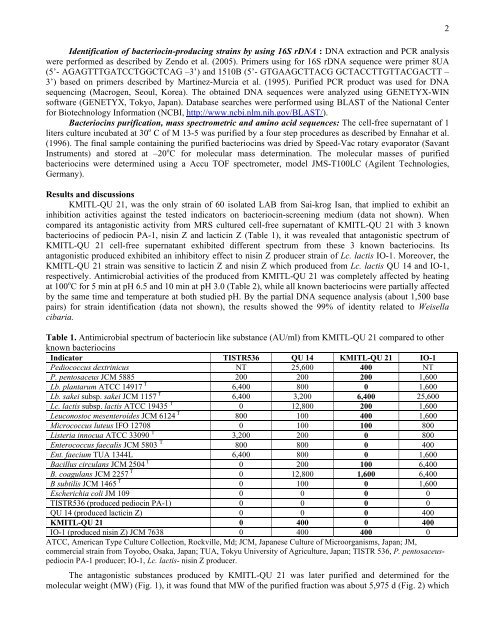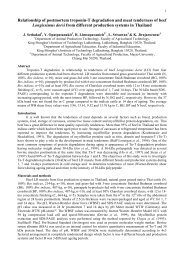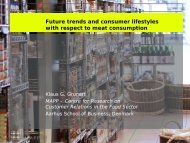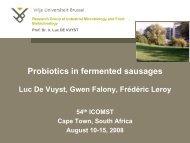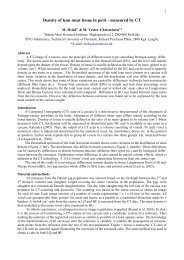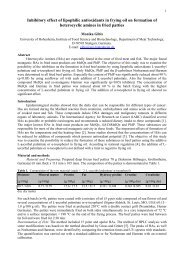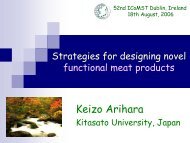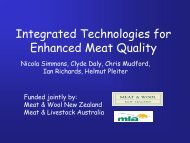A newly discovered bacteriocin from Weissella cibaria KMITL-QU 21
A newly discovered bacteriocin from Weissella cibaria KMITL-QU 21
A newly discovered bacteriocin from Weissella cibaria KMITL-QU 21
You also want an ePaper? Increase the reach of your titles
YUMPU automatically turns print PDFs into web optimized ePapers that Google loves.
Identification of <strong>bacteriocin</strong>-producing strains by using 16S rDNA : DNA extraction and PCR analysis<br />
were performed as described by Zendo et al. (2005). Primers using for 16S rDNA sequence were primer 8UA<br />
(5’- AGAGTTTGATCCTGGCTCAG –3’) and 1510B (5’- GTGAAGCTTACG GCTACCTTGTTACGACTT –<br />
3’) based on primers described by Martinez-Murcia et al. (1995). Purified PCR product was used for DNA<br />
sequencing (Macrogen, Seoul, Korea). The obtained DNA sequences were analyzed using GENETYX-WIN<br />
software (GENETYX, Tokyo, Japan). Database searches were performed using BLAST of the National Center<br />
for Biotechnology Information (NCBI, http://www.ncbi.nlm.nih.gov/BLAST/).<br />
Bacteriocins purification, mass spectrometric and amino acid sequences: The cell-free supernatant of 1<br />
liters culture incubated at 30 o C of M 13-5 was purified by a four step procedures as described by Ennahar et al.<br />
(1996). The final sample containing the purified <strong>bacteriocin</strong>s was dried by Speed-Vac rotary evaporator (Savant<br />
Instruments) and stored at –20 o C for molecular mass determination. The molecular masses of purified<br />
<strong>bacteriocin</strong>s were determined using a Accu TOF spectrometer, model JMS-T100LC (Agilent Technologies,<br />
Germany).<br />
Results and discussions<br />
<strong>KMITL</strong>-<strong>QU</strong> <strong>21</strong>, was the only strain of 60 isolated LAB <strong>from</strong> Sai-krog Isan, that implied to exhibit an<br />
inhibition activities against the tested indicators on <strong>bacteriocin</strong>-screening medium (data not shown). When<br />
compared its antagonistic activity <strong>from</strong> MRS cultured cell-free supernatant of <strong>KMITL</strong>-<strong>QU</strong> <strong>21</strong> with 3 known<br />
<strong>bacteriocin</strong>s of pediocin PA-1, nisin Z and lacticin Z (Table 1), it was revealed that antagonistic spectrum of<br />
<strong>KMITL</strong>-<strong>QU</strong> <strong>21</strong> cell-free supernatant exhibited different spectrum <strong>from</strong> these 3 known <strong>bacteriocin</strong>s. Its<br />
antagonistic produced exhibited an inhibitory effect to nisin Z producer strain of Lc. lactis IO-1. Moreover, the<br />
<strong>KMITL</strong>-<strong>QU</strong> <strong>21</strong> strain was sensitive to lacticin Z and nisin Z which produced <strong>from</strong> Lc. lactis <strong>QU</strong> 14 and IO-1,<br />
respectively. Antimicrobial activities of the produced <strong>from</strong> <strong>KMITL</strong>-<strong>QU</strong> <strong>21</strong> was completely affected by heating<br />
at 100 o C for 5 min at pH 6.5 and 10 min at pH 3.0 (Table 2), while all known <strong>bacteriocin</strong>s were partially affected<br />
by the same time and temperature at both studied pH. By the partial DNA sequence analysis (about 1,500 base<br />
pairs) for strain identification (data not shown), the results showed the 99% of identity related to Weisella<br />
<strong>cibaria</strong>.<br />
Table 1. Antimicrobial spectrum of <strong>bacteriocin</strong> like substance (AU/ml) <strong>from</strong> <strong>KMITL</strong>-<strong>QU</strong> <strong>21</strong> compared to other<br />
known <strong>bacteriocin</strong>s<br />
Indicator TISTR536 <strong>QU</strong> 14 <strong>KMITL</strong>-<strong>QU</strong> <strong>21</strong> IO-1<br />
Pediococcus dextrinicus NT 25,600 400 NT<br />
P. pentosaceus JCM 5885 200 200 200 1,600<br />
Lb. plantarum ATCC 14917 T 6,400 800 0 1,600<br />
Lb. sakei subsp. sakei JCM 1157 T 6,400 3,200 6,400 25,600<br />
Lc. lactis subsp. lactis ATCC 19435 T 0 12,800 200 1,600<br />
Leuconostoc mesenteroides JCM 6124 T 800 100 400 1,600<br />
Micrococcus luteus IFO 12708 0 100 100 800<br />
Listeria innocua ATCC 33090 T 3,200 200 0 800<br />
Enterococcus faecalis JCM 5803 T 800 800 0 400<br />
Ent. faecium TUA 1344L 6,400 800 0 1,600<br />
Bacillus circulans JCM 2504 T 0 200 100 6,400<br />
B. coagulans JCM 2257 T 0 12,800 1,600 6,400<br />
B subtilis JCM 1465 T 0 100 0 1,600<br />
Escherichia coli JM 109 0 0 0 0<br />
TISTR536 (produced pediocin PA-1) 0 0 0 0<br />
<strong>QU</strong> 14 (produced lacticin Z) 0 0 0 400<br />
<strong>KMITL</strong>-<strong>QU</strong> <strong>21</strong> 0 400 0 400<br />
IO-1 (produced nisin Z) JCM 7638 0 400 400 0<br />
ATCC, American Type Culture Collection, Rockville, Md; JCM, Japanese Culture of Microorganisms, Japan; JM,<br />
commercial strain <strong>from</strong> Toyobo, Osaka, Japan; TUA, Tokyu University of Agriculture, Japan; TISTR 536, P. pentosaceuspediocin<br />
PA-1 producer; IO-1, Lc. lactis- nisin Z producer.<br />
The antagonistic substances produced by <strong>KMITL</strong>-<strong>QU</strong> <strong>21</strong> was later purified and determined for the<br />
molecular weight (MW) (Fig. 1), it was found that MW of the purified fraction was about 5,975 d (Fig. 2) which<br />
2


